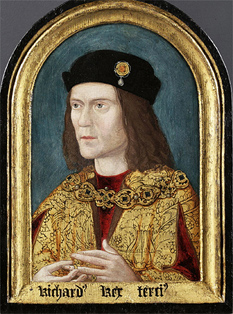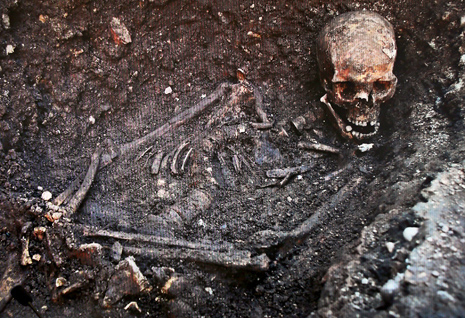Class News
Stephen Greenblatt on Richard III's exhumation
The Shape of a Life
The New Yorker
February 5, 2013

The announcement, on February 4th, that forensic analysis had confirmed that a skeleton unearthed six feet under a social-services parking lot, in the English Midlands city of Leicester, was that of the fifteenth-century King Richard III excited a startling rush of media attention. A hundred and forty registered journalists and camera crews from seven countries crowded into the press conference at the University of Leicester and filed past the bones laid out decorously on a black velvet cloth draped on four library tables pushed together. British blogs, television, and newspapers have offered minute-by-minute coverage of the event, coupled with testimony from archaeologists, historians, experts in carbon dating and mitochondrial DNA analysis, and excited members of the Richard III Society. The Society, founded in 1924 as the Fellowship of the White Boar (Richard's heraldic badge), is devoted to cleansing the tarnished image of the last Yorkist king, who reigned from 1483 until his death, two years later, at the Battle of Bosworth Field.
That battle ended the Wars of the Roses and ushered in the first of the Tudors, Henry VII. The new King, who had a lineal claim to the throne far weaker than the man he had just murdered, did what rulers in that situation always did: he encouraged his principal allies, such as his Archbishop of Canterbury and his Lord Chancellor, John Morton, to besmirch the reputation of the vanquished man. Henry got a particularly impressive version of what he sought in "The History of King Richard III," written by an ambitious young man who had served as a page in Morton's household. "The History" weaves together every dark rumor about Richard's brief life (he died at thirty-two) into a brilliant narrative, which paints a portrait of a bold, gifted, and ineradicably evil man whose evil was marked in his very body: "Little of stature, ill fetured of limmes, croke backed, his left shoulder much higher then his right, hard fauoured of visage." Even his birth had been a difficult one, and it was reported — though here the author of "The History" voices some reservation — that the newborn had teeth. In any case, he was, we are told, a particularly nasty piece of work: "Hee was close and secrete, a deepe dissimuler, lowlye, of counteynaunce, arrogant of heart, outwardly coumpinable" — i.e., friendly — "where he inwardely hated, not letting" — i.e., hesitating — "to kisse whome hee thoughte to kyll."
The author of this splendid hatchet job was Thomas More, who would go on to write "Utopia" and to lose his head at the hands of the second Tudor monarch, Henry VIII. More's "The History of Richard III" was incorporated into the major sixteenth-century chronicle histories and thus, in effect, became the authorized representation of the loser of the Battle of Bosworth Field. At the end of that battle, the corpse of the vanquished ruler — the last English king to die in combat — was not given a royal funeral but stripped of his armor, strapped to a horse, and ignominiously hauled back to Leicester for a humiliatingly modest interment. The process of denigration had begun.

Now, as a result of an inspired piece of archaeological detective work, the bones have unexpectedly surfaced from beneath the parking lot. Why their reappearance should thrill the members of the Richard III Society, who helped to fund the whole project, is not altogether clear. The base of the skull was shattered by a violent blow, probably from a halberd, that particularly gruesome two-handed pole weapon favored by late-medieval soldiers. So the King was presumably killed from behind, and his bones bear marks of what are called "humiliation injuries" — that is, stab wounds through the buttocks and elsewhere that must have been inflicted on his corpse by people in a frenzy of loathing.
But the most interesting piece of evidence is the spine, weirdly curved in a ghastly S. It's startling, seeming to confirm More's adjective "croke backed" and to conjure up the figure that has actually provoked the worldwide press coverage. That figure is not the historical Richard III but, rather, the fantastic villain that Shakespeare fashioned from More's slanders and unleashed in the early fifteen-nineties onto the London stage.
Shakespeare's Richard — "That bottled spider, that foul bunch-backed toad" (4.4.81) — was loathsome from birth. His own mother, the Duchess of York, recalls the earliest moments of her wicked son's miserable life,
A grievous burden was thy birth to me;
Tetchy and wayward was thy infancy (4.4.168-69),
He was the wretched'st thing when he was young,
So long a-growing, and so leisurely. (2.4.18-19)
Shakespeare even rehearses the story about the teeth. "They say my uncle grew so fast," says the little Duke of York (whom Richard will contrive to murder, along with his cousin), "that he could gnaw a crust at two hours old." "Who told thee this?" asks the Duchess.
YORK: Grannam, his nurse.
DUCHESS OF YORK: His nurse? Why, she was dead ere thou wast born.
YORK: If 'twere not she, I cannot tell who told me. (2.4.27-34)
If, like More, Shakespeare airs some skepticism about the dental prodigy, he spares Richard little else in the way of villainy: his King is a cunning, devious, ruthless, vicious murderer. And the playwright does something that More does not do, something that links the skeleton's weird spine directly to his life of crime. In More's "History," Richard's physical deformity is an uncanny sign of his viciousness, a kind of preternatural portent or emblem. In Shakespeare, it is the root condition of his psychopathology. There is nothing mechanical in this conditioning, certainly no suggestion that all men with twisted spines become cunning murderers. But Shakespeare does suggest that a child unloved by his mother, mocked by his peers, and forced to regard himself as a monster will develop certain compensatory psychological strategies, some of them both destructive and self-destructive.
Shakespeare had already come up with this idea in a preliminary sketch of the character in his early history play known as "3 Henry VI." Because, Richard declares, nature has cruelly chosen
To shrink mine arm up like a withered shrub;
To make an envious mountain on my back,
Where sits deformity to mock my body;
To shape my legs of an unequal size;
To disproportion me in every part (3 H 6 3.2.156-59),
he will abjure any hope of sexual success and will opt instead for the distinct but related pleasure it will bring him "to command, to check, to o'erbear such / As are of better person than myself" (3.2.166-7). In the famous soliloquy he gives his villain at the beginning of "Richard III" — "Now is the winter of our discontent / Made glorious summer by this son of York" — Shakespeare returns to and develops the same conception. "Deformed, unfinished, sent before my time / Into this breathing world scarce half made up," Richard declares that he will not attempt to be a lover but will pursue power by any means necessary.
The strange and surprising thing in "Richard III" is that the hunchback does, in fact, prove to be a weirdly successful suitor. He seduces Lady Anne, whose husband and father-in-law he has murdered, and more important, perhaps, in his jaunty wickedness and perverse humor, he has seduced more than four centuries of audiences. That seduction accounts for the excitement that the unearthing of the skeleton occasioned, and that skeleton in turn seems to confirm Shakespeare's intuition that there is a relationship between the shape of a spine and the shape of a life.
Stephen Greenblatt is a John Cogan University Professor of the Humanities at Harvard. His most recent book, The Swerve: How the World Became Modern, received the National Book Award and the Pulitzer Prize for nonfiction.

